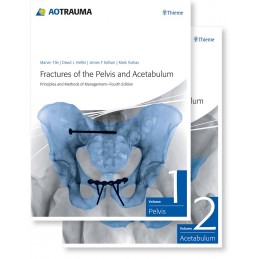- Reduced price

Order to parcel locker

easy pay


 Delivery policy
Delivery policy
Choose Paczkomat Inpost, Orlen Paczka, DHL, DPD or Poczta Polska. Click for more details
 Security policy
Security policy
Pay with a quick bank transfer, payment card or cash on delivery. Click for more details
 Return policy
Return policy
If you are a consumer, you can return the goods within 14 days. Click for more details
This well-known and highly regarded book by Marvin Tile et al. is now a two-volume set of books based on the AO principles of operative management of fractures, as applied to the pelvis and acetabulum. With the collaboration of over 80 international expert surgeons and through hundreds of images and illustrations, each volume emphasizes decision making based on the assessment of the personality of the injury through the patients history, physical examination, and interpretation of radiographic investigations. Access to video presentations demonstrating surgical approaches and reduction techniques performed by world-renowned experts is included.
Data sheet
Volume 1
Section 1 Principles of the treatment of pelvic ring injuries
1.1 Anatomy of the pelvic ring
1.2 Biomechanics and methods of internal fixation
1.3 Pathoanatomy, mechanisms of injury, and classification
1.4 General assessment and management of the polytrauma patient
1.5 Defining the injury: assessment and principles of management of pelvic ring fractures
Section 2 Techniques
1.6 Surgical apporaches to the pelvis
1.7 External fixation of the pelvic ring
1.8.1 Internal fixation of the injured pelvic ring: rationale
1.8.2 Internal fixation of the injured pelvic ring: navigation
1.8.3 The management of the injured pelvic ring: internal fixation of stable ring fractures (type A)
1.8.4 The management of the injured pelvic ring: internal fixation of the anterior pelvic injuries—open book type (B1)
1.8.5 Internal fixation of lateral compression fractures (type B2)
1.8.6 Internal fixation of unstable fractures (types B3 and C)
1.9 Sacral fractures
Section 3 Special indications
1.10 Lumbosacral instability and stabilization
1.11 Open pelvic fractures
1.12 Pelvic ring disruption in women: genitourinary and obstetrical implications
1.13 Urological injuries in pelvic ring trauma: assessment and management in male patients
1.14 Injury to the pelvis in pediatric patients: the immature skeleton
1.15 Insufficiency fractures of the pelvis
Section 4 Results and complications
1.16 Outcomes after pelvic ring injuries
1.17 Venous thromboembolism in pelvic trauma
1.18 Complications of pelvic trauma
1.19 Malunion and nonunion of the pelvis: posttraumatic deformity
Volume 2
Section 5 Principles of the treatment of acetabular fractures
2.1 Anatomy of the acetabulum
2.2 Biomechanics of acetabular fractures
2.3 Pathoanatomy and classification of acetabular fractures
2.4 Defining the injury: assessment and principles of management of acetabular fractures
2.5 Decison making: nonoperative and operative indications for treatment of acetabular fractures
2.6 General assessment and perioperative management of acetabular fractures
Section 6 Techniques
2.7 Specific surgical approaches and technique
2.8 Planning and decision making: surgical approaches
2.9.1 Computer-assisted closed techniques of reduction and fixation
2.9.2 Image intensifier-assisted closed techniques of reduction and fixation
2.10.1 Techniques of reduction and fixation for acetabular fractures: open methods
2.10.2 Surgical management of wall and column fractures (type A)
2.10.3 Surgical management of B types: B1, B2, B3
2.10.4 Surgical management of associated both-column fractures (type C)
2.11.1 Cerclage wires and cable fixation for an acetabular fracture
2.11.2 Intrapelvic approach in acetabular fractures
2.11.3 Use of bone substitutes
2.11.4 Intraoperative assessment of acetabular fractures
Section 7 Special situations
2.12 The elderly patient with an acetabular fracture
2.13 Primary total hip arthroplasty for acetabular fracture
2.14 Total hip arthroplasty after acetabular fracture
2.15 Pathological pelvic fractures and acetabular reconstruction in metastatic disease
2.16 Acetabular fracture in the pediatric patient: the immature skeleton
2.17 Posttraumatic acetabular dysplasia
Section 8 Results and complications
2.18 Early complications
2.19 Late complications
2.20 Surgical management of delayed acetabular fractures
2.21 Late acetabular reconstruction
2.22 Malunion and nonunion
2.23 Results of treatment for fractures of the acetabulum
